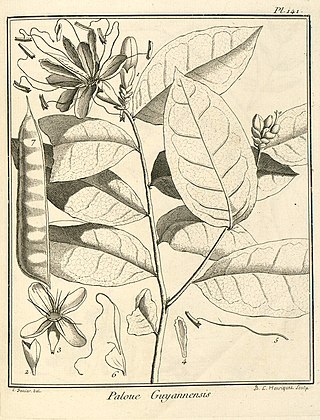
Meliaceae, the mahogany family, is a flowering plant family of mostly trees and shrubs in the order Sapindales.

Attalea maripa, commonly called maripa palm is a palm native to tropical South America and Trinidad and Tobago. It grows up 35 m (115 ft) tall and can have leaves or fronds 10–12 m (33–39 ft) long. This plant has a yellow edible fruit which is oblong ovoid and cream. An edible oil can be extracted from the pulp of the fruit and from the kernel of the seed.

Attalea is a large genus of palms native to Mexico, the Caribbean, Central and South America. This pinnately-leaved, non-spiny genus includes both small palms lacking an aboveground stem and large trees. The genus has a complicated taxonomic history, and has often been split into four or five genera based on differences in the male flowers. Since the genera can only be distinguished on the basis of their male flowers, the existence of intermediate flower types and the existence of hybrids between different genera has been used as an argument for keeping them all in the same genus. This has been supported by recent molecular phylogenies.
Orphanodendron is a genus of legume in the legume family, Fabaceae. It includes two species of trees native to Colombia, which grow in tropical lowland forest. The genus is in subfamily Faboideae.
Mickelia nicotianifolia is a species of fern in the family Dryopteridaceae, subfamily Elaphoglossoideae. It has a widespread distribution in Central America and northern South America.

Puya alpestris is a species of bromeliad endemic to the Chilean Andes. It is native to dry hills, rock outcrops in central and southern Chile at elevations of 0 to 2200 meters. It is one of the most southerly occurring species within the family. It is one of the few Puya species that are grown in some parks and gardens as an ornamental plant. It is more commonly known as the Sapphire Tower.

Leptolobium is a small Neotropical genus of plants in the family Fabaceae, with 12 species currently recognized. With the exception of Leptolobium panamense, which occurs in tropical forests from northwestern South America to Mexico, all species of Leptolobium are restricted to South America and most diverse in Brazil. Most Leptolobium species have been traditionally included in AcosmiumSchott (Fabaceae), but both genera have been recently distinguished based on several vegetative and reproductive traits.

Paloue is a genus of flowering plants in the family Fabaceae. It belongs to the subfamily Detarioideae. The genera was first created with the description of Paloue guianensis by Aublet in 1775.

Oxyrhynchus is a small genus of flowering plants in the legume family, Fabaceae. It includes four species, three native to the tropical Americas from northern Mexico to Colombia, and one native to New Guinea, Maluku, and the Bismarck Archipelago. It belongs to the subfamily Faboideae. A key for the species in this genus has been published.

The dolphin genus Sotalia is considered to have two member species with the classification of Sotalia guianensis as a distinct species from Sotalia fluviatilis in 2007. This was a result of recent morphometric analyses, as well as mitochondrial DNA analysis.

Pentaclethra macroloba is a large and common leguminous tree in the genus Pentaclethra native to the wet tropical areas of the northern Neotropics, which can form monocultural stands in some seasonally flooded habitats. It has giant, bipinnate leaves shaped like feathers. It uses seed dispersal by water to establish itself in new areas, having floating seeds that are left behind after the waters recede after floods or tides. It has hard timber which is not very resistant to rot in the tropics, but it can be treated, has a pretty pink-red colour when dry, and has a number of uses. Oil used in cosmetics is extracted from the large seeds. In the northern Amazon region the bark is used in herbal medicine as an antivenom, and in the Guianas the bark has been used as a fish poison. Despite their toxicity, the seeds are eaten by variegated squirrels, parrots and macaws, and serve as the nurseries of the larvae of the moth Carmenta surinamensis.
Caphys bilineata is a species of snout moth. It was described by Caspar Stoll in 1781. It is found in much of Central America and South America, including Arizona, Honduras, Panama, Bahamas, Cuba, Grenada, Guadeloupe, Puerto Rico, Saint Vincent, Brazil, Chile, Colombia, Ecuador, Peru, Suriname and Venezuela.

Lecythis ampla is a species of woody plant in the family Lecythidaceae, which also includes the Brazil nut. Common names include coco, olla de mono, jicaro and salero. It is found in Central and South America. It has been considered an endangered species in Costa Rica.

Panopsis is a genus of trees in the family Proteaceae. It is native to tropical regions in the Americas. Common areas where Panopsis species are seen to grow in are described to have elevated groundwater levels.

Carapa guianensis is a species of tree in the family Meliaceae, also known by the common names andiroba or crabwood.

Bryanthus is a monotypic genus of ornamental plant in the flowering plant family Ericaceae, with the sole species Bryanthus musciformis, native to Japan, Kamchatka, and the Kuril Islands. The genus was created in 1769. In 2012, the new tribe Bryantheae was proposed based on genetic analysis, containing the genera Bryanthus and Ledothamnus.
Psidium acidum is a species of tree in the family Myrtaceae. It is native to Peru and Ecuador.
Brian Morey Boom is an American botanist who specializes in the flora of the Guianas and the Caribbean, the family Rubiaceae, ethnobotany, and economic botany.

Carapa procera, called African crabwood, is a species of tree in the genus Carapa, native to the West African tropics and to the Amazon rainforest, and introduced to Vietnam. Some authorities have split off the South American population into its own species, Carapa surinamensis. The nuts are intensively collected in the wild for their oil, a non-timber forest product. In tropical Africa, the species is increasingly threatened.

Huberia is a genus of flowering plants belonging to the family Melastomataceae.
















